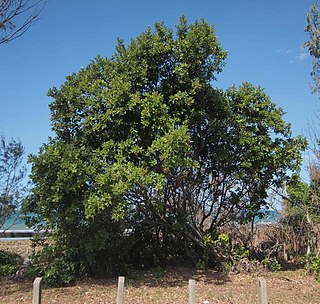
Alectryon is a genus of about 30 species of trees and shrubs from the family Sapindaceae. They grow naturally across Australasia, Papuasia, Melanesia, western Polynesia, east Malesia and Southeast Asia, including across mainland Australia, especially diverse in eastern Queensland and New South Wales, the Torres Strait Islands, New Guinea, the Solomon Islands, New Caledonia, New Zealand, Vanuatu, Fiji, Samoa, Hawaii, Indonesia and the Philippines. They grow in a wide variety of natural habitats, from rainforests, gallery forests and coastal forests to arid savannas and heaths.

Cupaniopsis is a genus of about 67 species of trees and shrubs of the soapberry family, Sapindaceae. They grow naturally in New Guinea, New Caledonia, Australia, Torres Strait Islands, Fiji, Samoa, Sulawesi, Micronesia. Many species have been threatened with extinction globally or nationally, with official recognition by the International Union for Conservation of Nature (IUCN) and several national and state governments.

Harpullia is a genus of about 27 species of small to medium-sized rainforest trees from the family Sapindaceae. They have a wide distribution ranging from India eastwards through Malesia, Papuasia and Australasia to the Pacific Islands. They grow naturally usually in or on the margins of rainforests or associated vegetation.

Jagera is a genus of 4 species of forest trees known to science, constituting part of the plant family Sapindaceae.

Diploglottis is a genus of 10 species of trees known to science, constituting part of the plant family Sapindaceae. They grow naturally in rainforests and margins of adjoining humid forests in eastern Australia and New Guinea. Some species are known as native tamarind or small-leaved tamarind; they have no direct relationship with the true tamarind.

Arytera is a genus of about twenty–eight species known to science, of trees and shrubs and constituting part of the plant family Sapindaceae. They grow naturally in New Guinea, Indonesia, New Caledonia, Australia, the Solomon Islands, Vanuatu, Fiji, Samoa, Tonga; and the most widespread species and type species A. littoralis grows throughout Malesia and across Southeast Asia, from NE. India, southern China, Borneo, Malaysia, Singapore, Indonesia and the Philippines to as far east as New Guinea and the Solomon Islands.

Atalaya is a genus of eighteen species of trees and shrubs of the plant family Sapindaceae. As of 2013 fourteen species grow naturally in Australia and in neighbouring New Guinea only one endemic species is known to science. Three species are known growing naturally in southern Africa, including two species endemic to South Africa and one species in South Africa, Eswatini and Mozambique.

Elattostachys is a genus of about 21 species of trees known to science, constituting part of the plant family Sapindaceae.

Lepiderema is a genus of nine species of trees from the family Sapindaceae. As of November 2013 botanists know of seven species growing naturally in Australia and two species in New Guinea. Published botanical science provides a limited knowledge of the full range of diversity in Australia and especially in New Guinea. In New Guinea the two known species have descriptions based each on only a single type specimen collection. Therefore, collection of more specimens and more species is most likely in New Guinea. In Australia they grow in rainforests of the northern half of the east coast side of the Great Dividing Range, from northeastern New South Wales through to northeastern Queensland.

Mischocarpus is a genus of about nineteen species of trees known to science, constituting part of the plant family Sapindaceae. They grow naturally from Australia and New Guinea, though Malesia as far north as the Philippines, through SE. Asia, Indo-China and S. China, to India at their farthest west. The eleven Australian species known to science grow naturally in the rainforests of the eastern coastal zone of New South Wales and Queensland, from Newcastle northwards through to north-eastern Queensland and Cape York Peninsula.
Alectryon ramiflorus is a species of endangered small seasonal rainforest trees from the plant family Sapindaceae. They are endemic to a very restricted area of southeastern Queensland, Australia. Threats of extinction to the species include habitat loss and disturbance of a catastrophic degree from wildfire or storms.

Gymnostoma australianum, commonly known as the Daintree pine or Daintree oak, is a species of small tree which is endemic to a restricted area of the Daintree tropical rainforests region, within the Wet Tropics of north-eastern Queensland, Australia. It is a member of the plant family Casuarinaceae, often named she-oaks, members of which are characterised by drooping equisetoid evergreen foliage, and separate male and female flowers (unisexual). Superficially they look like well known scale–leaved gymnosperm trees species, such as Cupressus in the northern hemisphere and Callitris in the southern hemisphere.
Hollandaea is a small genus of plants in the family Proteaceae containing four species of Australian rainforest trees. All four species are endemic to restricted areas of the Wet Tropics of northeast Queensland.

Mischarytera is a genus of rainforest trees, constituting part of the plant family Sapindaceae. Four species are known to science as of December 2013, found growing naturally in eastern Queensland, Australia, and in New Guinea. Formerly until 1995, they had names within the genus Arytera, subgenus Mischarytera.

Sarcotoechia is a genus of tropical rainforest trees, constituting part of the plant family Sapindaceae.

Synima is a genus of tropical rainforest trees, constituting part of the plant family Sapindaceae.
Lepidopetalum is a genus of six species of trees known to science, constituting part of the plant family Sapindaceae.
Dictyoneura is a genus of two-to-three species of rainforest trees known to science, constituting part of the plant family Sapindaceae.

Alectryon connatus, sometimes named hairy alectryon, is a species of small tree in the plant family Sapindaceae.

Cossinia is a genus of four species of rainforest trees, constituting part of the plant family Sapindaceae. The genus has a disjunct distribution, occurring in Mascarene Islands, Australia, New Caledonia and Fiji.
















